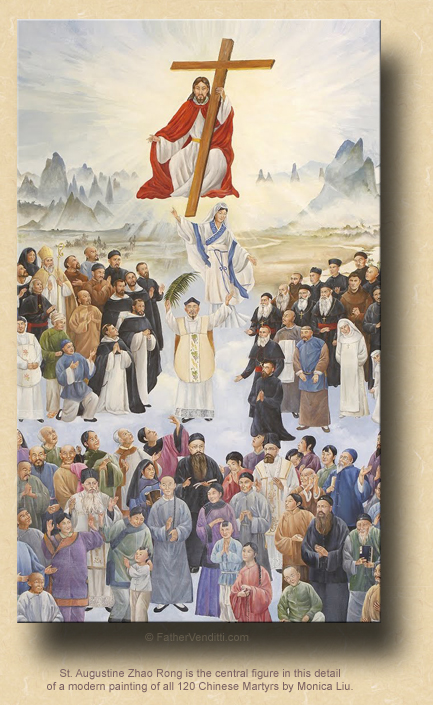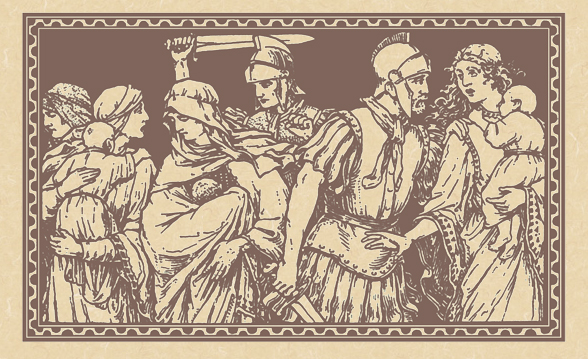One Hundred Twenty Reasons Not to Surrender.
The Fourthteenth Thursday of Ordinary Time; or, the Memorial of Saint Augustine Zhao Rong, Priest, & Companions, Martyrs.
Lessons from the primary feria, according to the ordinary form of the Roman Rite:
• Genesis 44: 18-21, 23-29; 45: 1-5.
• Psalm 105: 16-21.
• Matthew 10: 7-15.
The Sixth Thursday after Pentecost.
Lessons from the dominica,* according to the extraordinary form of the Roman Rite:
• Romans 6: 3-11.
• Psalm 89: 13, 1.
• Mark 8: 1-9.
The Sixth Thursday after Pentecost; and, the Feast of the Holy Martyr Pancratius, Bishop of Taormina.
Lessons from the pentecostarion, according to the Ruthenian recension of the Byzantine Rite:
• I Corinthians 7: 24-35.
• Matthew 15: 12-21.
FatherVenditti.com
|
 1:27 PM 7/9/2015 — Today's commemoration is a very unusual one: the calendar of the Latin Church honors on this day 120 martyrs who died in China in scattered intervals between 1648 and 1930. Eighty-seven of them were born in China, and included children as young as nine, and men and women as old as seventy-two. Included among them were four Chinese priests. Thirty-three of them were foreign born missionaries working in China, from a variety of different religious congregations: the Paris Foreign Mission Society, the Franciscans, the Jesuits, the Salesians, the Franciscan Missionaries of Mary, and including the Dominican Priest St. Francis Capillas, who is regarded as the proto-Martyr of China; he was killed on January 15th, 1648. 1:27 PM 7/9/2015 — Today's commemoration is a very unusual one: the calendar of the Latin Church honors on this day 120 martyrs who died in China in scattered intervals between 1648 and 1930. Eighty-seven of them were born in China, and included children as young as nine, and men and women as old as seventy-two. Included among them were four Chinese priests. Thirty-three of them were foreign born missionaries working in China, from a variety of different religious congregations: the Paris Foreign Mission Society, the Franciscans, the Jesuits, the Salesians, the Franciscan Missionaries of Mary, and including the Dominican Priest St. Francis Capillas, who is regarded as the proto-Martyr of China; he was killed on January 15th, 1648.
The one man whose name is mentioned in the Collect of today's Mass, St. Augustine Zhao Rong, was originally a soldier who had been assigned to guard Bishop John Gabriel Taurin Dufresse of the Paris Foreign Mission Society and escort him to his execution when the time came for him to give his life for Christ. He was so moved by the bishop's courage, that he later sought baptism, and not long after that was ordained a diocesan priest; he, himself, was martyred in 1815.
Over the next one hundred years, all of these people would be beatified in groups at various times, but all one hundred twenty of them were canonized together on October 1st, 2000, by Pope St. John Paul II. It's the only time that I can remember that so many people, who died over so long a period, were all canonized at one time.
Of course, the Church in China continues to suffer to this day, and there are martyrdoms taking place there every day, martyrdoms that we may never know about until, perhaps, a hundred years from now.
Most of the saints we honor today probably didn't know one another; they were bound together not by social interaction but by a common faith and a desire to bring their country to salvation through Christ. And while there are optional readings I could have chosen for their feast related to missionaries and martyrs, I chose instead to stick to the readings of the day, the Gospel of which contains some of our Lord's instructions to his original Twelve Apostles as He sends them out to preach (Matt. 10: 7-15). They probably had less of an idea of what they were getting into than the Chinese martyrs we honor today.
We may think that we don't have much in common with these 120 martyrs of China, but we're wrong. There are many different kinds of martyrdom: not just martyrdom of blood, but also martyrdom of mind, martyrdom of loneliness, martyrdom of despair and desperation. I'm not suggesting that we're worthy of canonization if we spend a good part of our lives depressed; I am suggesting that, as we suffer the many crosses that the Lord, in his permissive will, allows to come our way for whatever reason, we could do worse than to ask these 120 brave souls for their spiritual help. Given the almost unfathomable courage with which these people—many of whom, as I said, were children—went to their deaths, I can only suppose that their intercession carries great influence before the Throne of Christ our true God.

* On ferias outside of privileged seasons, the lessons are always taken from the preceding Sunday.
|

